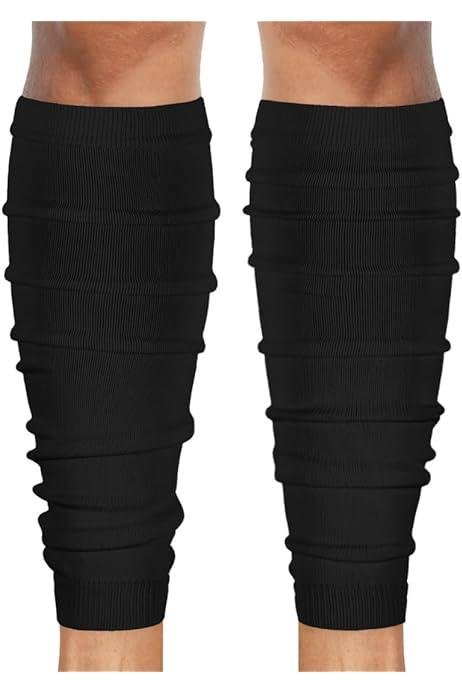In the high-stakes, high-impact world of football, every piece of equipment plays a crucial role in ensuring player safety and optimizing performance. Among these essential gear items, leg sleeves have emerged as a vital component, offering a multitude of benefits that extend far beyond simple aesthetic appeal. These sleeves are not just fashion statements; they are advanced tools designed to enhance protection and performance through a combination of compression, padding, and thermal regulation.
From improving blood flow to providing critical padding that absorbs impact, leg sleeves serve as a frontline defense against injuries and environmental hazards. They help retain heat to keep muscles warm and performing at their peak, while also offering protection against abrasions and other external factors. This post will delve into the science and practical advantages of football leg sleeves, highlighting why they have become an indispensable part of a football player’s protective gear.
Compression and blood flow
In the dynamic and physically demanding sport of football, every edge counts. One of the key advantages that leg sleeves offer is through their compression capabilities, which have a direct impact on blood flow. Compression garments, including leg sleeves, have been shown to increase blood flow in the legs by up to 30%. This significant boost in circulation is not merely a number; it translates into tangible benefits for players on the field.
The enhanced blood flow facilitated by compression garments plays a crucial role in reducing muscle fatigue and soreness. When muscles are well-supplied with blood, they receive a steady stream of oxygen and nutrients, which are essential for maintaining peak performance. This constant supply helps muscles to function more efficiently and recover more quickly, allowing players to maintain their intensity throughout the game.
Moreover, compression helps to prevent the pooling of blood in the legs, a common issue that can lead to swelling and other problems. By applying consistent pressure, leg sleeves promote the return of blood to the heart, ensuring that it doesn’t stagnate in the lower extremities. This not only reduces the risk of swelling but also contributes to overall better circulation, which is vital for maintaining optimal physical performance.
In addition, the improved circulation brought about by compression garments also enhances oxygen delivery to the muscles. Oxygen is the fuel that powers muscle activity, and when muscles receive an adequate supply, they can perform at their best. This improved oxygen delivery can lead to increased endurance, strength, and overall athletic performance, making compression leg sleeves an invaluable asset for any football player looking to optimize their game.
Padding for impact absorption
Padding in football leg sleeves serves as an essential line of defense against the high-impact nature of the sport. These sleeves are designed with strategic padding to minimize the force of tackles and collisions, thereby significantly reducing the risk of injuries. The cushioning effect of the padding material plays a crucial role in protecting the underlying tissue, lessening the severity of injuries that may occur during intense gameplay. This added layer of protection is particularly important for football players who are constantly exposed to hard hits and sudden impacts.
The padding in leg sleeves not only absorbs impact but also enhances joint and muscle stability. By providing additional support, these sleeves help to mitigate the risk of sprains and strains, which are common injuries in football. The stability offered by the padding ensures that the leg muscles and joints are well-protected, allowing players to perform at their best without the constant fear of injury. This is especially beneficial for players who have a history of leg injuries, as the extra support can prevent recurrences and promote long-term health.
Incorporating advanced features such as gel inserts or foam padding further bolsters the protective capabilities of leg sleeves. These innovative materials are specifically engineered to absorb and disperse impact more effectively than traditional padding. Gel inserts, for instance, can conform to the shape of the leg, providing a customized fit that enhances comfort and protection. Similarly, foam padding can be designed to offer varying levels of support, ensuring that the sleeves cater to the unique needs of each player. These advanced features are a testament to the ongoing innovation in sports equipment, aimed at providing football players with the best possible protection.
Overall, padded leg sleeves are a crucial component of a football player’s protective gear. They offer a comprehensive solution to the challenges posed by high-impact situations, combining impact absorption, tissue protection, and enhanced stability. By incorporating these sleeves into their equipment, players can significantly reduce their risk of injury and perform with greater confidence on the field.
Heat retention and muscle performance
Football leg sleeves offer a broad array of benefits that surpass basic compression. A primary function is regulating muscle temperature, which is vital for optimal performance on the field. By retaining heat, these sleeves maintain ideal muscle temperature, especially in cooler conditions. Muscles that are warmer demonstrate increased flexibility and are less prone to injuries like strains and tears, making heat conservation a key element in preventing harm.
The thermal properties of football leg sleeves extend beyond just providing warmth. They promote better blood flow, essential for delivering oxygen and nutrients to the muscles. Enhanced circulation not only boosts endurance and strength but also speeds up recovery. Warmer muscles are more efficient at turning energy into movement, enabling players to maintain high-intensity activity for extended periods.
Moreover, the heat-retaining capabilities of leg sleeves are instrumental in reducing post-game muscle soreness and fatigue. By keeping muscles at an optimal temperature throughout the game, sleeves help minimize the buildup of lactic acid, a common cause of muscle fatigue. This temperature control ensures that players can recover faster and be ready for their next training session or match with less discomfort.
In essence, the thermal advantages of football leg sleeves are wide-ranging, including improved muscle performance, reduced injury risk, and quicker recovery. These sleeves are more than just protective gear; they are performance enhancers, making them a crucial part of a football player’s equipment.
Protection against abrasions
Football, a dynamic and intense sport, exposes players to a variety of injuries due to its physical nature and rapid movements. Among these, abrasions, cuts, and turf burns are prevalent yet often underestimated. These injuries can result from sliding tackles, falls, or even minor contact with the field’s abrasive surface. Here, football leg sleeves emerge as a vital piece of equipment, acting as a defensive layer between the player’s skin and external hazards. By shielding the lower leg, these sleeves significantly lower the risk of skin damage, enabling players to immerse themselves in the game with enhanced assurance and minimal disruptions.
The protective advantages of leg sleeves aren’t limited to immediate injury prevention. They also offer substantial sanitary benefits that promote the players’ overall health. Football fields, both natural and artificial, can be breeding grounds for bacteria, dirt, and other microorganisms that can cause infections if they infiltrate open wounds or abrasions. Leg sleeves function as a safeguard, preserving skin integrity and minimizing exposure to these detrimental elements. This protective aspect is particularly crucial in football, where players are constantly in close contact with each other and the playing surface.
Furthermore, the materials utilized in football leg sleeves are engineered to be breathable and moisture-wicking, amplifying their defensive attributes. By maintaining skin dryness and coolness, these sleeves inhibit the accumulation of sweat and moisture that can foster bacterial proliferation. This not only diminishes the risk of skin irritations and infections but also elevates the player’s overall comfort, permitting them to concentrate more on their athletic performance rather than discomfort or potential health hazards.
The significance of football leg sleeves in shielding players’ skin from abrasions, cuts, and potential infections is undeniable. By serving as a barrier against external threats and upholding skin hygiene, these sleeves offer a holistic solution for bolstering player safety and comfort on the field. Their incorporation into a football player’s protective gear underscores their efficacy in mitigating the risk of common yet avoidable injuries, ultimately fostering a more enjoyable and secure playing experience.
Protection against environmental factors
Football leg sleeves offer a multifaceted layer of protection against various environmental factors, ensuring players can perform at their best regardless of external conditions. One of the primary benefits is temperature regulation, a crucial aspect for maintaining optimal performance. In hot conditions, leg sleeves are designed with moisture-wicking materials that draw sweat away from the skin, keeping players cool and dry. This feature helps prevent overheating and dehydration, allowing athletes to sustain their energy levels throughout the game. Conversely, in cold weather, the insulating properties of these sleeves provide an added layer of warmth, protecting muscles from stiffness and potential injuries that could arise from exposure to low temperatures.
In addition to temperature control, football leg sleeves provide essential protection against sun exposure. With extended periods spent outdoors, players are at risk of harmful UV rays, which can lead to sunburn and long-term skin damage. Many leg sleeves are crafted with UPF (Ultraviolet Protection Factor) materials that block out a significant portion of these rays, safeguarding the skin and reducing the risk of sun-related issues. This feature is particularly valuable during long training sessions or games played under intense sunlight.
Moreover, leg sleeves act as a barrier against precipitation, whether it’s rain, snow, or other forms of moisture. The water-resistant properties of these sleeves ensure that the legs remain dry, preventing discomfort and potential skin irritations. This is crucial for maintaining focus and performance, as wet conditions can lead to distractions and even affect the player’s grip and movement. Additionally, leg sleeves offer protection against insects, which can be a nuisance during outdoor games. By covering the skin, these sleeves prevent insect bites and the irritation they cause, allowing players to concentrate fully on their game without unnecessary distractions.
Overall, the protective benefits of football leg sleeves against environmental factors are indispensable for maintaining peak performance. By regulating temperature, shielding against sun exposure, repelling moisture, and preventing insect bites, these sleeves enable players to stay comfortable and focused, regardless of the weather or external conditions. This comprehensive protection not only enhances player safety but also contributes to their overall ability to perform at the highest level.
Conclusion
In the dynamic world of football, every piece of protective gear plays a crucial role in ensuring players’ safety and enhancing their performance. Among these essentials, leg sleeves stand out for their multifaceted benefits that go beyond mere protection. By incorporating advanced compression technology, these sleeves significantly boost blood flow in the legs, leading to reduced muscle fatigue and soreness. This improved circulation not only aids in quicker recovery but also enhances endurance and strength, making a notable difference in a player’s overall athletic performance.
Moreover, the padding in leg sleeves acts as a shield against potential injuries, safeguarding players’ legs from the rigors of the game. This added layer of protection is invaluable in a high-contact sport like football, where the risk of impact injuries is ever-present. Additionally, the thermal regulation properties of these sleeves help maintain optimal muscle temperature, preventing strains and ensuring players can perform at their peak throughout the game.
Beyond injury prevention and performance enhancement, leg sleeves offer protection against environmental elements and turf abrasions. Whether it’s the harsh cold of winter games or the intense UV rays of summer matches, these sleeves provide a barrier that keeps players comfortable and focused. This comprehensive protection against external factors further underscores the value of leg sleeves in a football player’s arsenal.
In conclusion, the incorporation of leg sleeves into a football player’s protective gear is a strategic move that yields comprehensive benefits. From optimizing blood flow and reducing muscle exhaustion to shielding against injuries and regulating muscle temperature, these sleeves are a vital asset for any player aiming to excel on the field. By addressing both the physical demands of the game and the environmental challenges, leg sleeves significantly enhance players’ safety and on-field capabilities, making them an indispensable part of modern football gear.




More Stories
Benefits of Reviewing PTE Mock Test Results
Why You Need a Temporary Phone Number for Verification
Retirement Financial Planning: Building a Secure Future